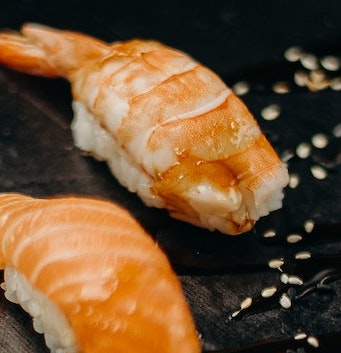Have you ever wondered why you often find sushi, a classic Japanese dish, on the menu at your favorite Thai restaurant? It might seem odd at first. After all, Thai and Japanese foods are quite different. But there are good reasons why so many Thai restaurants serve sushi.
In this article, we’ll explore those reasons. We’ll look at the history of Thai and Japanese food, and see how these two cuisines have influenced each other over time. We’ll also explore how certain ingredients are used in both Thai and Japanese dishes. Plus, we’ll dive into the world of fusion cuisine, where chefs blend elements from different food traditions to create something new and exciting.

Table of Contents
A Historical Connection: Thai and Japanese Relations
The Silk Road: A Historical Culinary Corridor
The Silk Road, an ancient network of trade routes that connected the East and the West, had a profound impact on the world’s culinary landscape. Thailand and Japan, situated at key junctures along these routes, inevitably exchanged food products, recipes, and cooking techniques, shaping their cuisines in significant ways.
Trade and Migration: A Powerful Culinary Influence
Over centuries, trading and migration patterns have consistently altered culinary traditions. Thai and Japanese people moved along trade routes, carrying with them culinary practices that infiltrated local cuisines. The presence of sushi in Thai restaurants is a modern-day reflection of these historical ties.
Japanese Influence in Thailand during World War II
The Japanese occupation of Thailand during World War II played a significant role in the cultural and culinary exchange between the two countries. The Japanese populace in Thailand introduced their food culture, which inevitably influenced Thai cuisine. Post-war, these influences remained, further strengthened by Japanese businesses setting up in Thailand, bringing with them an increased demand for Japanese food.
The Post-War Boom of Japanese Restaurants in Thailand
In the aftermath of World War II, Thailand saw a surge of Japanese immigrants and businesses. This growth sparked an increased demand for Japanese cuisine, leading to the rise of Japanese restaurants in Thailand. Over time, sushi became a familiar and favored dish, eventually making its way into Thai restaurants.
Economic and Cultural Exchange in the 20th Century
The 20th century marked an era of increased economic and cultural exchange between Thailand and Japan, further enhancing their culinary connections. Japanese investments in Thailand led to an influx of Japanese workers, which in turn increased the demand for Japanese cuisine. Similarly, Thai people traveling to Japan for work or leisure returned home with a newfound appreciation for Japanese food, particularly sushi
Culinary Similarities and Shared Ingredients
Despite their distinct individualities, Thai and Japanese cuisines have several overlapping elements, including the use of similar ingredients and cooking methods.
Rice: The Foundation of Both Cuisines
In both Thai and Japanese culinary traditions, rice holds a pivotal role. It’s a staple food, used in an array of dishes from main courses to desserts. In Japanese cuisine, sushi rice, seasoned with vinegar, sugar, and salt, forms the base of sushi. The transition to sushi in Thai restaurants is therefore quite organic given their familiar foundation of rice-based dishes.
A Sea of Possibilities: Seafood
The geographical locations of Thailand and Japan, both nations with extensive coastlines, contribute to their shared reliance on seafood. Fresh fish, shellfish, and other marine delicacies feature prominently in both cuisines. The introduction of sushi, which often includes raw or lightly cooked seafood, aligns seamlessly with this established seafood tradition in Thai cuisine.
The Art of Balance: Sweet, Sour, Salty, and Spicy
Thai and Japanese cuisines both excel in achieving a balance of flavors – sweet, sour, salty, and spicy. In sushi, this harmony is often reflected through the combination of sushi rice, fish, and condiments like soy sauce and pickled ginger. This shared emphasis on balanced flavor profiles enables Thai restaurants to incorporate sushi in their menus with ease, knowing it aligns with their culinary ethos.
Mutual Love for Freshness
Freshness of ingredients is a defining feature of both Thai and Japanese cuisines. This is particularly evident in sushi, which often incorporates raw seafood, requiring the highest standards of freshness. This shared emphasis on fresh ingredients makes sushi a natural fit for Thai menus.
Herbs and Spices: Adding Flavor and Aroma
Thai and Japanese cuisines both use a wide range of herbs and spices to enhance their dishes. In sushi, wasabi and ginger are commonly used, adding heat and tanginess. Thai food also employs an array of aromatic herbs and spices. The common usage of these flavor-enhancing ingredients makes sushi an acceptable and adaptable addition to Thai cuisine.
Current Market Trends and Consumer Preferences
The evolving consumer preferences and market trends also offer insight into why Thai restaurants often include sushi in their menus.
A Taste for Variety
Modern consumers appreciate diverse food options. Including sushi in the menu allows Thai restaurants to cater to a wider range of taste preferences, offering a novelty that is exciting for many diners.
Health Consciousness
Sushi is known for its use of fresh ingredients and lower calorie content, making it an attractive choice for the health-conscious. Thai restaurants serving sushi tap into this growing trend, attracting a larger clientele base.
The Advent of Fusion Cuisine
Fusion cuisine is a culinary movement that merges different regional or national culinary traditions, often bringing together contrasting flavors and techniques to create innovative dishes. Its advent has greatly influenced how Thai restaurants have adopted sushi, blending the lines between Thai and Japanese cuisines.
The Birth of Fusion Cuisine
Fusion cuisine began as a response to the increasingly globalized world of the late 20th century. As international travel grew more common, people were exposed to a variety of new cuisines. Chefs started experimenting, combining elements from different culinary traditions to create unique, innovative dishes.
Thai-Japanese Fusion: A Popular Culinary Trend
One of the most popular fusion trends is the blending of Thai and Japanese cuisines. Thai-Japanese fusion dishes, such as Thai sushi rolls, feature the quintessential ingredients of sushi, like sushi rice and nori, but replace traditional Japanese fillings with Thai flavors, such as spicy chili, lemongrass, or coconut. This melding of flavors offers an exciting, unique culinary experience, making Thai sushi rolls a popular menu item in Thai restaurants.
The Appeal of Fusion Cuisine
Fusion cuisine appeals to many because it provides a novel dining experience. It allows food lovers to explore unique flavor combinations and cooking techniques, breaking away from traditional culinary boundaries. The inclusion of sushi in Thai restaurants plays into this appeal, providing diners with a unique Thai-Japanese culinary experience.
Fusion Restaurants: The Best of Both Worlds
The success of fusion cuisine has led to the rise of restaurants specializing in this type of cuisine. These establishments offer the best of both worlds, providing a diverse menu that appeals to a wide range of tastes. The popularity and success of Thai-Japanese fusion restaurants reinforce the trend of serving sushi in Thai restaurants.
Conclusion
Understanding why many Thai restaurants have sushi on their menus requires a look at the historical, cultural, and market-driven factors that have led to this fusion of culinary traditions. With the rising popularity of fusion cuisine and a market that values diversity and health-conscious choices, it’s likely that we’ll continue to see sushi featured in Thai restaurants around the globe.

